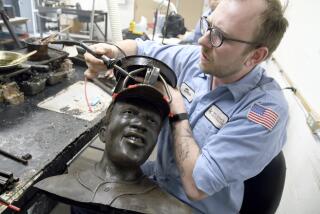Debris From Statue’s Renovation to Be Sold : Some Liberty Can Be Yours--for a Price
- Share via
NEW YORK — Chunks of concrete, bars of rusted metal and slabs of brass are stacked, piled, heaped high in a Brooklyn warehouse.
It looks like worthless trash and debris, but John R. Stocks looks at the mess and sees artwork. Flag stands. Commemorative coins. Wall plaques. Statuettes. Paperweights.
Stocks, an entrepreneur of detritus, has paid at least $12 million for these ancient bolts and dented copper sheets--all pried from the interior of the Statue of Liberty as the monument undergoes restoration. And he expects to turn them into a monumental profit.
“There’s an old saying in this business that one man’s trash is another man’s treasure,” said the 47-year-old Stocks, a good-humored Southerner raised in Georgia and now living in Tallahassee, Fla. “It’s never been truer than here.”
Henning Nielsen, a spokesman for the Statue of Liberty-Ellis Island Foundation, which is renovating the statue, said of the castoff materials, “We like to call them ‘venerable objects’ rather than debris.” He said the foundation wants the stuff handled “in a dignified and appropriate manner.”
No problem, said Stocks. He has already gone through rigorous review by the foundation and the National Park Service to win a license to package and sell the debris from the statue and from the old immigration buildings at nearby Ellis Island.
“They were going to take the debris, the material, and dispose of it--take it out to sea and dump it,” he said. “It was probably just in the way to them. We viewed it in a different perspective.”
Stocks’ perspective was that of a self-made real estate developer and “incurable optimist.” He read about the project in a newspaper, thought about mementos of the project and hit upon the idea of marketing the debris.
The foundation “wanted a presentation to the Park Service, which is very protective of the grand old lady,” Stocks recalled. “We had to go jump a few hoops and convince them we were (as) concerned as they were.”
A stack of cash provided a boost: The $12 million that Stocks is paying the foundation, plus a percentage of additional sales, makes his Gold Leaf Corp. the biggest corporate donor to the project, which is expected to cost $250 million to $300 million.
The foundation is stressing a different aspect of the deal: It is the first time consumers can buy pieces of any national monument. And this, after all, is the Statue of Liberty.
“It makes chills run up and down your back,” Stocks said. “It’s real emotional. It’s a part of history that’s within the reach of every American.”
The materials gathered so far--”the guts from the first six floors,” said Chris Yonclas, Gold Leaf’s vice president--are locked up in Brooklyn. The pile includes the statue’s old elevator, stairs and railings.
Packaging the Debris
The shape of the junk’s future is up to a group led by John Behringer, a professor at the Rhode Island School of Design. He plans to keep much of the material in its natural form--a bolt encased in plastic, a metal bar set into a display stand.
“We’re treating it as a historical find,” Behringer said. “If it were dumped in the bay, 1,000 years from now people would be spending millions to dive in and pull it out.”
Stocks said some of the metal would be ground into dust, then molded into statuettes, medallions, even Christmas tree ornaments. Concrete will be pulverized, then pressed into plaques or flag stands.
The designs of the souvenirs and the advertising used to sell them must be approved by the foundation and the Park Service. The finished goods, which will cost from $10 to $5,000 or more, Stocks said, should be in stores and direct-mail catalogs by April 1.
The statue’s renovation is to be finished by July, 1986 for its centennial celebration. The Ellis Island complex should be done in 1992.
More to Read
Sign up for Essential California
The most important California stories and recommendations in your inbox every morning.
You may occasionally receive promotional content from the Los Angeles Times.













